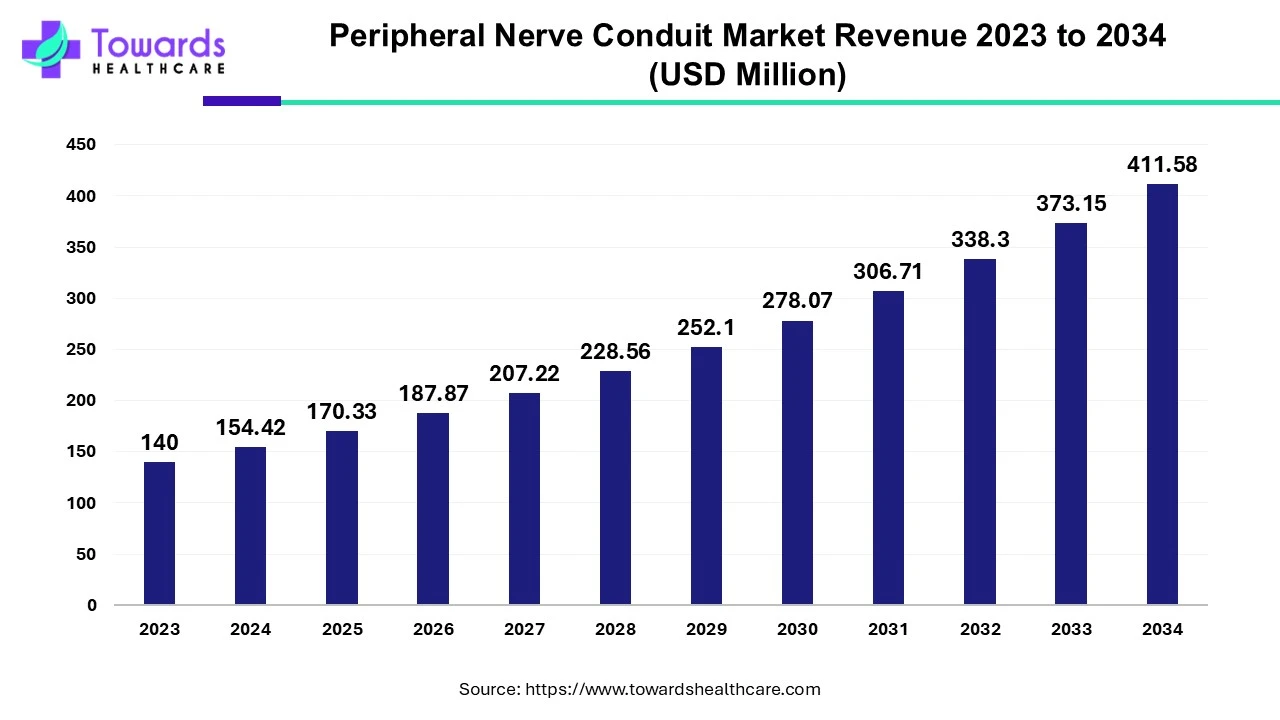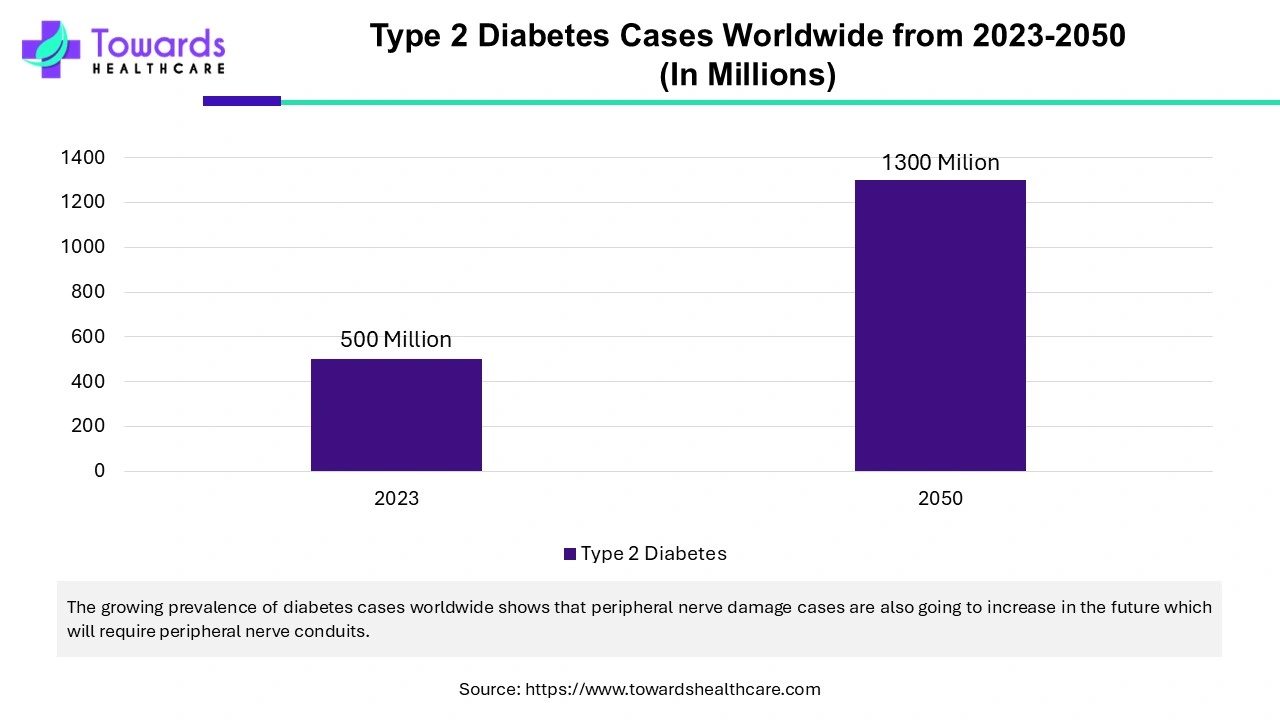November 2024


Principal Consultant

Reviewed By
The global peripheral nerve conduit market was estimated at US$ 140 million in 2023 and is projected to grow to US$ 411.58 million by 2034, rising at a compound annual growth rate (CAGR) of 10.3% from 2024 to 2034. The demand for nerve conduit is increasing due to growing cases of autoimmune disorders which are one of the causes of nerve damage.

The peripheral nerve conduit market encompasses the production and distribution of nerve conduits that are used for repairing peripheral nerves. Conduits are made of synthetic and natural materials. The most frequent injury types that impact the neurological system are peripheral nerve injuries (PNIs). Restoring nerve function following PNI is a difficult medical problem. There is growing interest in neural guide conduits (NGCs) as a possible substitute for nerve autografts. In recent research, artificial nerve conduits have emerged as a viable substitute for autologous nerves.
In April 2024, a €5 million fundraising round was successfully closed, according to neuroClues®, a MedTech business that specializes in the identification of neurodegenerative illnesses. Following a €4.7 million investment in 2021 and €2.5 million in funds from the European Commission's EIC Accelerator, neuroClues® has raised a total of €12 million with its most recent fundraising round. Additionally, the business has been chosen to receive up to €9 million in extra funding from the EIC Fund.

Diabetes is a very common condition impacting millions of people every year. Unhealthy eating habits, a sedentary lifestyle, alcohol consumption, occupational hazards, and many more factors are contributing to the growing cases of diabetes. A dangerous consequence of diabetes that can impact up to 50% of diabetics is diabetic neuropathy. Diabetic neuropathy most commonly occurs in the peripheral area.
All surgical procedures include some risk, and nerve graft surgery is no exception. These concerns include infection, scarring, and problems with wound healing. It is also conceivable that an individual will not return to the predicted level of function.
North America dominated the peripheral nerve conduit market in 2023. Technological advancements drive the market in North America. With technological advancements, nerve repair surgeries are being conducted using robots, and minimally invasive surgeries are conducted, which are better than the traditional methods. The region also has advanced equipment and infrastructure that help provide better healthcare and improve patient satisfaction.
The U.S. dominates the peripheral nerve conduit market in North America due to the advanced healthcare system and the growing prevalence of diabetes. Millions of people in the United States suffer from peripheral neuropathy. In the U.S., diabetes is the main cause of peripheral neuropathy. In almost two-thirds of diabetics, nerve issues range from minor to severe.
Asia Pacific is expected to grow at the fastest rate during the forecast period. Diabetes is the leading cause of peripheral neuropathy and may need peripheral nerve conduit. The growing prevalence of diabetes is the major cause of the growth of the peripheral nerve conduit market.
It was predicted that between 2020 and 2030, the prevalence of diabetes in Chinese individuals aged 20 to 79 will rise from 8.2% to 9.7%. The overall expenses of diabetes would rise from $250.2 billion to $460.4 billion over the same time span, representing a 6.32% annual growth rate.
India has roughly 101 million individuals suffering from diabetes and another 136 million people in pre-diabetic stages, according to a newly released report by the Madras Diabetes Research Foundation and Indian Council of Medical Research. Peripheral neuropathy (PN) is a prevalent condition that poses diagnostic and treatment challenges for neurologists and doctors. The total frequency of PN in different community surveys ranged from 5 to 2400 cases per 10,000 persons in epidemiological studies conducted in different parts of India.
By type, the synthetic materials segment dominated the peripheral nerve conduit market in 2023. The use of synthetic polymers in the construction of nerve conduits is appealing because their diverse chemical and technical characteristics enable modifications to the conduits' mechanical strength, porosity, degradation, biocompatibility, and geometric design.
The natural materials segment is estimated to grow at the fastest rate during the forecast period. Nerve conduits have been made from a variety of natural materials, such as collagen, fibronectin, laminin, and veins. The advantages of these materials include improved biocompatibility, less toxicity, and higher migration of supporting SCs.
By end-user, the hospitals segment dominated the peripheral nerve conduit market in 2023 and is estimated to remain dominant during the forecast period. Hospitals are dominant because hospitals have the equipment and resources needed for nerve repair. Trained and highly skilled professionals are involved and provide multidisciplinary care, increasing patient satisfaction.
By type
By End-User
By Region
November 2024
December 2024
October 2024
December 2024